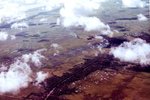The B29 wasn't successful at high altitude the early raids were close to disastrous high losses and almost nothing hit. The Americans switched to night time incendiary raids at 8,000 to 15000ft not exactly what it was designed to do. The B29 still needed escorting in daytime and couldnt really hit much from 30000 ft I cant see that using it un Europe would have had any more effect than the B17s and B24s.
Two main problems with high altitude bombing in Europe
1 an obscured target even if it isnt always raining here its often cloudy.
2 at high altitude there are frequently very high winds making estimates of ground speed difficult, I frequently fly across the North sea and these winds can change the flight time by plus or minus 10 minutes on a 55 minute flight
Two main problems with high altitude bombing in Europe
1 an obscured target even if it isnt always raining here its often cloudy.
2 at high altitude there are frequently very high winds making estimates of ground speed difficult, I frequently fly across the North sea and these winds can change the flight time by plus or minus 10 minutes on a 55 minute flight

